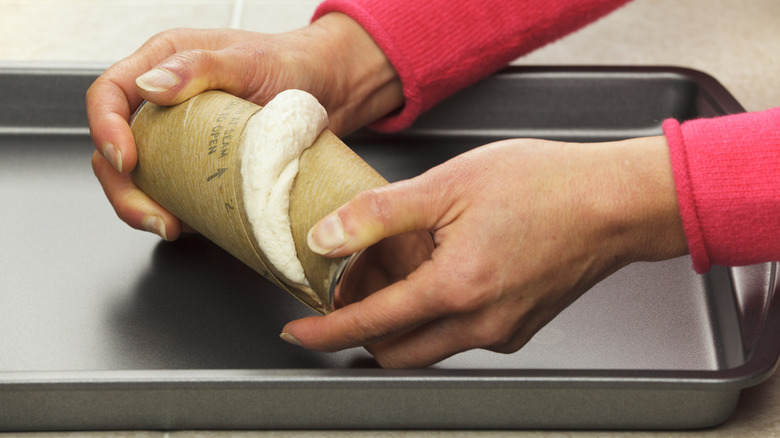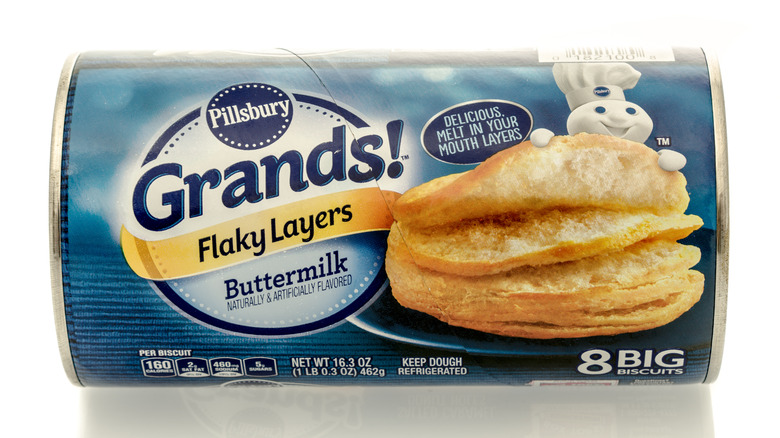The Freezer Mistake That Ruins Canned Biscuit Dough
When you compare the convenience of a canned biscuit versus the taste and texture of a homemade one, they are actually pretty balanced. Homemade buttermilk biscuits are undoubtedly better tasting than the mass-produced versions, but they take time and skill to make. Store-bought refrigerated dough isn't as tasty, but it's effortless, and there's a lot to be said for the ease of popping open a can and having warm, buttery biscuits on the table within 15 minutes.
Since canned biscuit dough can also be an invaluable shortcut for making entrees like pot pies and monkey bread, keeping a few on hand at all times makes sense. Although many of us have pushed the limits, using canned biscuits a few weeks past their printed expiration dates, it's safer to turn to the freezer in hopes of preserving the dough.
The good news is that canned biscuit dough can be frozen for up to two months. The entire tube can be placed in the freezer or divided if you prefer to sneak one or two out at a time. Set the unwrapped biscuits on a sheet pan and freeze them until solid, ensuring they aren't touching. Then, transfer the frozen biscuits to a resealable freezer-safe bag. Although expediting the process can be tempting, thawing them on the countertop is a mistake. Enabling the dough to defrost rapidly ruins the fluffy dough and could lead to a messy cleanup.
How to properly defrost canned biscuits
Although packages of Pillsbury brand biscuits warn against freezing the raw dough, that's to preserve the quality of the product, not for the consumer's safety. Please adhere to the label's warning against eating the dough raw. That can lead to foodborne illnesses like E. coli and Salmonella if contaminated flour isn't cooked thoroughly.
It's only worth freezing the dough if you're going to take the time to appropriately defrost. Within two months of freezing, the canned biscuits should be slowly thawed in the refrigerator overnight. Otherwise, the pressurized package can explode as you relieve some pressure by peeling away the label, causing the dough to ooze out. The warmed dough is very sticky, making it nearly impossible to separate the biscuits evenly. This affects their appearance and, more importantly, their texture.
It's essential to keep biscuit dough chilled before baking. Similar to homemade biscuits, allowing the butter or shortening to melt before going in the oven prevents the dough from rising as it bakes and changes the biscuit's texture, making it dense and gummy.
Previously frozen biscuits should be baked according to the manufacturer's instructions. Although the thawing process may prevent the biscuits from rising to their full potential, they will still taste as expected.
Tips for using defrosted canned biscuits
Since previously frozen canned biscuits likely won't fully rise, you may want to reserve them for certain recipes. While they may not be ideal for the bread basket, they still make a delicious topping for chicken pot pies, casseroles, or chicken and dumpling recipes.
Use the dough to fill muffin tins to create individual biscuit cups that you can stuff with infinite toppings. Try a pizza version by placing marinara sauce, shredded mozzarella, and diced toppings in every cup, customizing each one. Add taco meat, salsa, and shredded cheddar cheese for a Mexican-inspired meal that can be topped with guacamole and sour cream before serving. Defrosted biscuits are also ideal for making empanadas or savory pockets, which don't need to puff up during baking. Precook the fillings, then encase them with the dough before baking.
To make the easiest breakfast sandwiches, scramble eggs with toppings like bacon, crumbled sausage, cheese, or the veggies you fancy. Use a knife to create a pocket in the middle of each raw biscuit and fill the cavities with the mixture. Crimp the edges to seal the filling and brush the tops with melted butter before sprinkling salt or try everything biscuit seasoning. Bake them until the biscuits are golden brown and the filling is heated through. Allow the breakfast sandwiches to cool, then wrap each in foil and store them in the freezer. When ready to enjoy, unwrap the sandwich and microwave for about a minute until heated.



